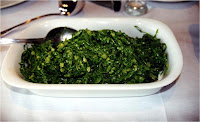In Fortaleza, Thursday night means crabs (Portuguese: caranguejo). The weekend starts officially on Thursday evenings on the city's most popular beach, Praia do Futuro, when throngs of hungry and thirsty locals descend on any one of a number of beachfront bar/restaurants for a caranguejada. This word can be tanslated as a crab-fest, a crab-orgy or a crab-blowout depending on how many crabs one consumes. It's not gourmet food, but it's authentic, local and delicious. (And a bargain - last night two of us shared four crabs. Each one costs R$2.70 - Brazilian reais - which works out to approximately $1.50 USD per crab).
Fortaleza's beach is lined with establishments called barracas. They provide all the services one might need for a day, or evening, at the beach. There's always bar and food service, bathrooms and fresh-water showers, music (often live), and palm-thatched sun shelters on the beach itself. Last night we visited one called America do Sol for our crab tasting. Under a high thatched ceiling, open to the sea-breeze and night air, tables were set up simply for the crab-fest. There were no tableclothes for reasons that soon became obvious - eating crabs Fortaleza-style is a messy business! A group of about ten musicians sat in a circle in the middle of the restaurant playing traditional acoustic samba music. The crowd consisted of young singles, family groups, tourists, couples - a real mix.
The technique for eating these crabs is simplicity itself. The piece of granite is used to hold the crab. Legs and claws are pulled off and pulled apart, using the hammers when necessary. Each bit is dipped into the broth, then slurped and sucked to extract the meat and the flavor. Some continue on with the body of the crab, but most people limit themselves to the limbs. Two crabs satiate a large appetite, but there are some people who eat three or four.
The coast of Ceará state is lined with beaches and with mangrove swamps, and it`s in the swamps where crabs are harvested. There is no commercial farming of crabs in Ceará, and all the crabs are wild. They, apparently, are not endangered, and thrive, even with a Thursday night crab-fest to supply every week.
Visiting Fortaleza without experiencing a Thursday night crab-fest is unthinkable. Choose from a number of barracas, order crabs and beer, and dig-in!
For a video on the Thursday crab-fest, including some wonderful samba music, click on this post (coming soon).













































